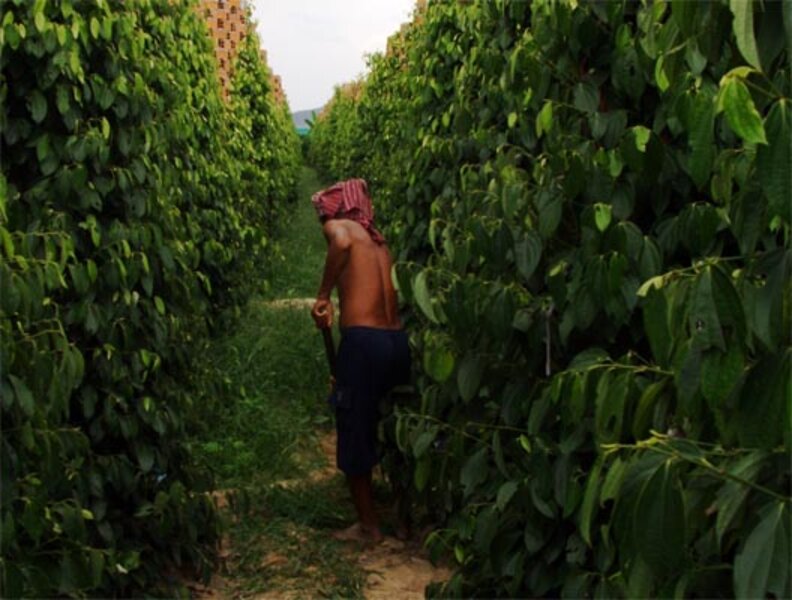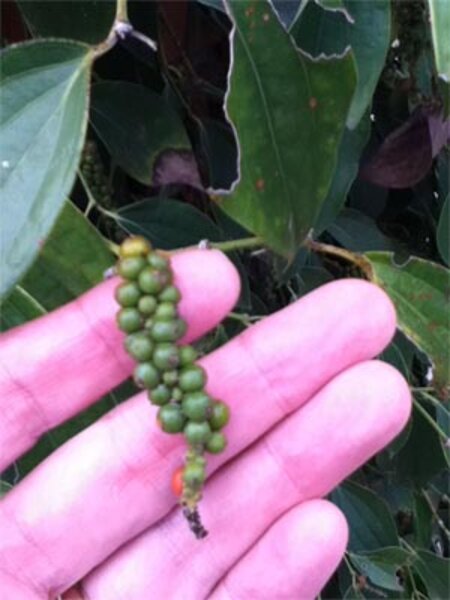Travel: A visit to a Cambodian pepper plantation
Loading...
“Bong – how much farther?” Our oldest son, Roswell, was asking our tuktuk driver how much longer we’d be bouncing along this potholed dirt road somewhere in Cambodia. In Khmer (pronounced “k’MAI,”), you address any male older than you as “bong”: it means “older brother.”
We were heading toward a pepper plantation that the driver had assured us he knew how to find. There were five of us jammed into the tuktuk – a four-passenger cart pulled by a motorcycle. (It’s like riding in an escaped carnival ride.) We’d left the riverside city of Kampot in southern Cambodia far behind; past the city center with its giant statue of a durian fruit, past endless low shops lining either side of the asphalt road, and onto a dirt track. We had been bouncing along like this for maybe 20 minutes.
“Ten minutes,” the driver said.
We passed small neat farms, with one-story houses up on stilts, Brahma cows strolling by or lying down, and strutting long-legged chickens. Emerald-green swaths of – something. Is that what rice looks like? Little children wearing shorts would wave vigorously as we chugged past and shout “Hello!” They seemed delighted to make a connection. Their lively greetings sounded like bird calls.
But now the landscape was getting scruffier, more hilly. There was more exposed red dirt, and no farms. Where was he taking us?
Ten minutes later we passed a sign for the Starling Farms pepper plantation, and soon bumped to a halt. We’d arrived, our driver indicated, and pointed down the slope. I saw rows of what looked like evenly spaced green towers. As we got closer, we saw that the towers were openwork brick columns, like chimneys, about 10 feet tall. They were wrapped in lush green vines – pepper plants, which in the wild wrap around the trunks of trees. We spotted the green berries, peppercorns, clumped in strings about three inches long. Most of the berries were small and green, but a few – no more than three per clump – were red.
The rows of towers stretched into the distance. We saw a few workers, wearing the typical Khmer head cloths, hoeing among the towers.
“Be careful of the ants,” our driver warned. Leaf-weaver ants can sting, but they also attack other insects. On this certified organic farm, we learned later, further insect control was achieved by soaking in water the leaves of a weed that grows naturally among the plants, and then spraying the concoction on the plants; it’s a natural insect repellent. Workers rub the leaves on their arms to keep biting insects away. All the fertilizer used is organic, too: cow dung, bat guano (from nearby caves), small fish, plant matter – and more of the insect-repelling weeds. The fertilizer is composted anaerobically in big underground pits, then spread on the plants.
We could go up to the gift shop, our driver said. And just as we approached a rather grand-looking two-story stone home, someone driving a big Land Rover pulled up – the owner, it turned out. The gift shop was the front room of his house, which overlooked the plantation in the valley below. It seemed a beautiful, tranquil spot.
“I originally bought the land as a getaway from Phnom Penh,” said owner Mark Hanna, a CPA originally from Derry, Ireland. He mostly lives and works in the city, a grueling four-hour drive. In fact, the roads were so bad that he’d considered buying a helicopter, he said, to get back and forth more easily. He’d also considered buying a brick factory – and now wished that he had. He’d needed a million bricks to make the pepper towers. And now, with building in nearby Vietnam booming, the cost of bricks had gone up 1,000 percent. His wife, Anna (“to be honest,” Mark said, “she does all the work”), who is Cambodian, plans to expand the plantation. But they’d be using cheaper, less durable wooden towers this time.
“See that white house over there?” Mark said, as we continued chatting. He was pointing far out to the right. “That was the Khmer Rouge headquarters for southeastern Cambodia.”
This used to be a dangerous place, indeed. Before the murderous reign of the Maoist Khmer Rouge, American B-52s had plastered the valley with bombs in an attempt to disrupt the Viet Cong’s supply routes in the late stages of the Vietnam War. The so-called Ho Chi Minh Trail had led right through this valley. It was a moonscape of craters when he got here some 13 years ago, he said, as we surveyed what was now an unbroken green expanse. He had chosen one of the craters to serve as the basement of a new outbuilding, in fact. But when the mechanical excavator hit something that went “Clunk!” all the workers had panicked and run, thinking it was an unexploded bomb. It was a bomb – but only a piece of one: the nosecone. He showed it to us; rusty, brown, and bent, but recognizable
We stood amid racks of various kinds of pepper for sale, in vacuum-sealed packets and souvenir wooden boxes and silk pouches. Pepper grinders, too. Four kinds of pepper are produced here, all from the same plant: The fresh green peppercorns, the unripe berries of the pepper plant, are good only for a few days after picking. They have a fresh, citrusy taste, not as strong as the dried black pepper. We’d tried some in the field. (Very good with seafood, we were told; especially the famous crabs caught in nearby Kep.) Riper green peppercorns are harvested from mature vines when the berries start to turn yellow. Dried in the sun on bamboo mats for a few days, they turn black, then are sterilized and packed. Dried correctly, they last many years. But once ground, they lose flavor rapidly – hence the importance of a pepper grinder. Black pepper is by far the most popular kind.
The red peppercorns on the mostly-green strings of berries (Mark called them “drupes”) are separated out by hand. Red pepper is rare, and not as well known. It has a sweeter, some say a fuller taste, and isn’t as hot as black pepper. (Shoppers beware: Some of the "red pepper" sold in supermarkets is actually a weird dried berry from Brazil.) Half the fully ripe pepper berries are sun-dried and become red pepper; half are soaked in water for a few days, which removes the reddish skin. What’s left are white peppercorns, which have a much different taste. Removing the skin removes some of the flavor components. White pepper is most often used when black or red pepper would spoil the visual effect, as in a white sauce.
Kampot is famous for its pepper, and it’s been grown here for at least 1,000 years. A Chinese traveler chronicled pepper cultivation here in 1200; the Chinese were the first to recognize the unique flavor of Cambodia's pepper, according to the Starling Farm’s website. Mark said the sought-after flavor was a product of the soil here, mostly.
His wife, Anna, cut up a mango for us while we decided what to buy. We were sort of in a hurry, now; it was a long ride back. We bought a few small bags of pepper as gifts, and a bag of mixed peppercorns for ourselves. I bought a big bag of what I thought at the time were black peppercorns – only to discover when I got back home – to my delight – that it was a big bag of dried red peppercorns.
A rare souvenir from a rare, enlightening, and bumpy trip.
Owen Thomas is the deputy editor for the weekly Monitor magazine.








